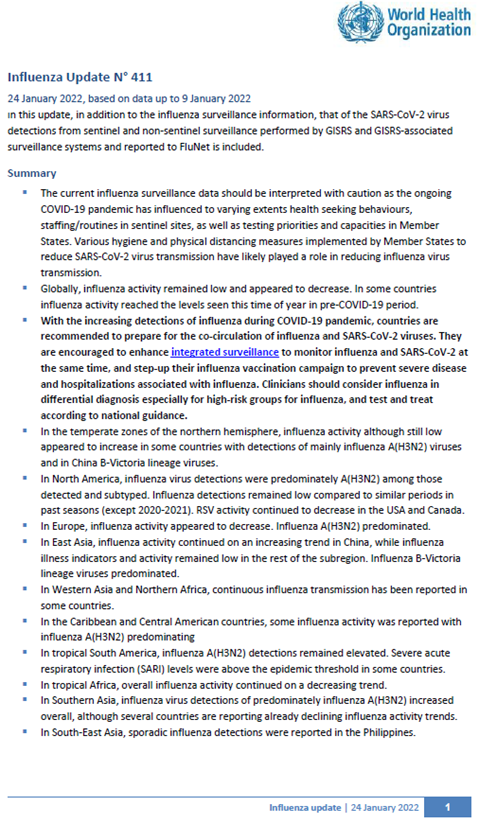Influenza Update N° 411

Overview
24 January 2022, based on data up to 9 January 2022
Information in this report is categorized by influenza transmission zones, which are geographical groups of countries, areas or territories with similar influenza transmission patterns. For more information on influenza transmission zones, see the link below:
Influenza Transmission Zones (pdf, 659kb)
- The current influenza surveillance data should be interpreted with caution as the ongoing COVID-19 pandemic has influenced to varying extents health seeking behaviours, staffing/routines in sentinel sites, as well as testing priorities and capacities in Member States. Various hygiene and physical distancing measures implemented by Member States to reduce SARS-CoV-2 virus transmission have likely played a role in reducing influenza virus transmission.
- Globally, influenza activity remained low and appeared to decrease. In some countries influenza activity reached the levels seen this time of year in pre-COVID-19 period.
- With the increasing detections of influenza during COVID-19 pandemic, countries are recommended to prepare for co-circulation of influenza and SARS-CoV-2. They are encouraged to enhance integrated surveillance to monitor influenza and SARS-CoV-2 at the same time, and step-up their influenza vaccination campaign to prevent severe disease and hospitalizations associated with influenza. Clinicians should consider influenza in differential diagnosis especially for high-risk groups for influenza, and test and treat according to national guidance.
- In the temperate zones of the northern hemisphere, influenza activity although still low appeared to increase in some countries with detections of mainly influenza A(H3N2) viruses and in China B-Victoria lineage viruses.
- In North America, influenza virus detections were predominately A(H3N2) among those detected and subtyped. Influenza detections remained low compared to similar periods in past seasons (except 2020-2021). RSV activity continued to decrease in the USA and Canada.
- In Europe, influenza activity appeared to decrease. Influenza A(H3N2) predominated.
- In East Asia, influenza activity continued on an increasing trend in China, while influenza illness indicators and activity remained low in the rest of the subregion. Influenza B-Victoria lineage viruses predominated.
- In Western Asia and Northern Africa, continuous influenza transmission has been reported in some countries.
- In the Caribbean and Central American countries, some influenza activity was reported with influenza A(H3N2) predominating.
- In tropical South America, influenza A(H3N2) detections remained elevated. Severe acute respiratory infection (SARI) levels were above the epidemic threshold in some countries.
- In tropical Africa, overall influenza activity continued on a decreasing trend.
- In Southern Asia, influenza virus detections of predominately influenza A(H3N2) increased overall, although several countries are reporting already declining influenza activity trends.
- In South-East Asia, sporadic influenza detections were reported in the Philippines.
- In the temperate zones of the southern hemisphere, influenza activity remained low overall, although increased detections of influenza A(H3N2) were reported in some countries in temperate South America.
- National Influenza Centres (NICs) and other national influenza laboratories from 99 countries, areas or territories reported data to FluNet for the time period from 27 December 2021 to 09 January 2022* (data as of 2022-01-21 07:58:14 UTC). The WHO GISRS laboratories tested more than 317198 specimens during that time period. 16862 were positive for influenza viruses, of which 10744 (63.7%) were typed as influenza A and 6118 (36.3%) as influenza B. Of the sub-typed influenza A viruses, 224 (4.3%) were influenza A(H1N1)pdm09 and 4930 (95.7%) were influenza A(H3N2). Of the characterized B viruses, 5959 (100%) belonged to the B-Victoria lineage.

During the COVID-19 pandemic, WHO encourages countries, especially those that have received the multiplex influenza and SARS-CoV-2 reagent kits from GISRS, to continue routine influenza surveillance, test samples from influenza surveillance sites for influenza and SARS-CoV-2 viruses where resources are available and report epidemiological and laboratory information in a timely manner to established regional and global platforms (see the guidance here: https://apps.who.int/iris/rest/bitstreams/1316069/retrieve).
- At the global level, SARS-CoV-2 percent positivity from sentinel surveillance continued to increase overall. Activity was under 10% positivity in the Eastern Mediterranean, South-East Asian and Western Pacific Regions of WHO. In the European Region of WHO, positivity continued on an increasing trend to 25%. In the African Region of WHO as well as the Region of the Americas of WHO, activity was very high with positivity above 40%. Overall positivity from non-sentinel sites also continued on an increasing trend.
- NICs and other national influenza laboratories from 49 countries, areas or territories from six WHO regions (African Region: 1; Region of the Americas: 13; Eastern Mediterranean Region: 4; European Region: 25; South-East Asia Region: 2; Western Pacific Region: 4 ) reported to FluNet from sentinel surveillance sites for time period from 27 Dec 2021 to 09 Jan 2022 (data as of 2022-01-21 07:58:14 UTC). The WHO GISRS laboratories tested more than 34179 sentinel specimens during that time period and 11552 (33.8%) were positive for SARS-CoV-2. Additionally, more than 2 million non-sentinel or undefined reporting source samples were tested in the same period and 690533 were positive for SARS-CoV-2. Further details are included at the end of this update.
Source of data
______________________________________________________________________________________________
The Global Influenza Programme monitors influenza activity worldwide and publishes an update every two weeks. The updates are based on available epidemiological and virological data sources, including FluNet (reported by the WHO Global Influenza Surveillance and Response System), FluID (epidemiological data reported by national focal points) and influenza reports from WHO Regional Offices and Member States. Completeness can vary among updates due to availability and quality of data available at the time when the update is developed.
*It includes data only from countries reporting on positive and negative influenza specimens.
